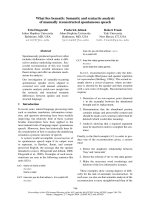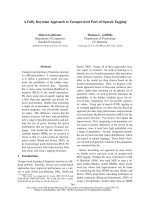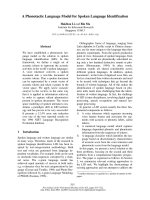Báo cáo khoa học: "A Cascaded Finite-State Parser for Syntactic Analysis of Swedish" potx
Bạn đang xem bản rút gọn của tài liệu. Xem và tải ngay bản đầy đủ của tài liệu tại đây (374.25 KB, 4 trang )
Proceedings of EACL '99
A Cascaded Finite-State Parser
for Syntactic Analysis of Swedish
Dimitrios Kokkinakis and Sofie Johansson Kokkinakis
Department of Swedish/Spr£kdata
Box 200, SE-405 30
G6teborg University, Ghteborg
SWEDEN
{svedk,svesj}@svenska.gu.se
Abstract
This report describes the development
of a parsing system for written Swedish
and is focused on a grammar, the
main component of the system, semi-
automatically extracted from corpora. A
cascaded, finite-state algorithm is ap-
plied to the grammar in which the input
contains coarse-grained semantic class
information, and the output produced
reflects not only the syntactic structure
of the input, but grammatical functions
as well. The grammar has been tested
on a variety of random samples of dif-
ferent text genres, achieving precision
and recall of 94.62% and 91.92% respec-
tively, and average crossing rate of 0.04,
when evaluated against manually disam-
biguated, annotated texts.
1 Introduction
This report describes a parsing system for fast
and accurate analysis of large bodies of written
Swedish. The grammar has been implemented
in a modular fashion as finite-state, cascaded
machines, henceforth called
Cass-SWE,
a name
adopted from the parser used,
Cascaded analy-
sis of syntactic structure,
(Abney, 1996). Cass-
SWE operates on part-of-speech annotated texts
and is coupled with a pre-processing mechanism,
which distinguishes thousands of phrasal verbs,
idioms, and multi-word expressions. Cass-SWE
is designed in such a way that semantic informa-
tion, inherited by named-entity (NE) identifica-
tion software, is taken under consideration; and
grammatical functions are extracted heuristically
using finite-state transducers. The grammar has
been manually acquired from open-source texts
by observing legitimately adjacent, part-of-speech
chains, and how and which function words sig-
nal boundaries between phrasal constituents and
clauses.
2 Background
2.1 Cascaded Finite-State Automata
Finite-state technology has had a great impact on
a variety of Natural Language Processing applica-
tions, as well as in industrial and academic Lan-
guage Engineering. Attractive properties, such as
conceptual simplicity, flexibility, and space and
time efficiency, have motivated researchers to cre-
ate grammars for natural language using finite-
state methods: Koskenniemi
et al.
(1992); Ap-
pelt
et al.
(1993); Roche (1996); Roche & Schabes
(1997). The cascaded, finite-state mechanism we
use in this work is described in Abney (1997):
" a finite-state cascade consists of a se-
quence of strata, each stratum being de-
fined by a set of regular-expression pat-
terns for recognizing phrases. [ ] The
output of stratum 0 consists of parts of
speech. The patterns at level l are applied
to the output of level I-1 in the manner
of a lexicaI analyzer [ ] longest match
is selected (ties being resolved in favour
of the first pattern listed), the matched
input symbols are consumed from the in-
put, the category of the matched pattern
is produced as output, and the cycle re-
peats ",
(p. 130).
2.2
Swedish Finite-State Grammars
There have been few attempts in the past to model
Swedish grammars using finite-state methods. K.
Church at MIT implemented a Swedish, regular-
expression grammar, inspired by ideas from Ejer-
hed & Church (1983). Unfortunately, the lexicon
and the rules were designed to parse a very lim-
ited set of sentences. In Ejerhed (1985), a very
245
Proceedings of EACL '99
general description of Swedish grammar was pre-
sented. Its algorithmic details were unclear, and
we are unaware of any descriptions in the liter-
ature of large scale applications or implementa-
tions of the models presented. It seems to us
that Swedish language researchers are satisfied
with the description and, apparently, the imple-
mentation on a small scale of finite-state meth-
ods for noun phrases only, (Cooper, 1984; Rauch,
1993). However, large scale grammars for Swedish
do exist, employing other approaches to parsing,
either radically different, such as the
Swedish Core
Language Engine,
(Gamb£ck & Rayner, 1992), or
slightly different, such as the
Swedish Constraint
Grammar,
(Birn, 1998).
2.3 Pre-Processing
By pre-processing we mean: (i) the recognition of
multi-word tokens, phrasal verbs and idioms; (ii)
sentence segmentation; (iii) part-of-speech tag-
ging using Brill's (1994) part-of-speech tagger,
and the EAGLES tagset for Swedish, (Johansson-
Kokkinakis & Kokkinakis, 1996). The general ac-
curacy of the tagger is at the 96% level, (98,7%
for the evaluation presented in table (1)). Tagging
errors do not influence critically the performance
of Cass-SWE 1 (cf. Voutilainen, 1998); (iv) se-
mantic inheritance in the form of NE labels:
time
sequences, locations, persons, organizations, com-
munication and transportation means, money ex-
pressions
and
body-part.
The recognition is per-
formed using finite-state recognizers based on trig-
ger words, typical contexts, and typical predicates
associated with the entities. The performance of
the NE recognition for Swedish is 97.4% preci-
sion, and 93.5% recall, tested within the AVENTI-
NUS 2 domain. Cass-SWE has been integrated
in the
General Architecture for Text Engineering
(GATE), Cunningham
et al.
(1996).
3 The Grammar Framework
The Swedish grammar has been semi-
automatically extracted from written text
corpora by observing two phenomena: (i) which
part-of-speech
n-grams,
are not allowed to be
adjacent to each other in a constituent, and (ii)
1The parser can be tolerant of the errofieous anno-
tation returned by the tagger, e.g. in the distinction
between Swedish adjective-participles in (:t). This is
accomplished by constructing rules that contain either
adjective or participle in the following manner:
np + AKTICLE(ADJECTIVEIPARTICIPLE) NOUN
2AVENTINUS (LE-2238),
Advanced Informa-
tion System for Multilingual Drug Enforcement.
(
how and which function words signal bound-
aries between phrases and clauses. (i) uses
the
Mutual Information,
statistics, based on
the n-grams. Low n-gram frequencies, such
as verb/noun-determiner, gave reliable cues
for clause boundary, while high values such as
numeral-noun did not, and thus rejected. Obser-
vation (i) is related to the notion of
distituent
grammars, " a distituent grammar is a list
of tag pairs which cannot be adjacent within a
constituent ",
Magerman & Marcus (1990); (ii)
is a supplement of (i), which recognizes formal
indicators of subordination/co-ordination, such
as conjunctions, subjunctions, and punctuation.
3.1 Syntactic Labelling and the
Underlying Corpus
The syntactic analysis is completed through the
recognition of a variety of phrasal constituents,
sentential clauses, and subclauses. We follow
the proposal defined by the EAGLES (1996),
Syntactic Annotation Group,
which recognizes
a number of syntactic, metasymbolic categories
that are subsumed in most current categories of
constituency-based syntactic annotation. The la-
belled bracketing consists of the syntactic cate-
gory of the phrasal constituent enclosed between
brackets. Unlabelled bracketing is only adopted
in cases of unrecognized syntactic constructions.
The corpora we used consisted of a variety of
different sources, about 200,000 tokens, collected
in AVENTINUS. The rules are divided into lev-
els, with each level consisting of groups of
pat-
terns
ordered according to their internal complex-
ity and length. A pattern consists of a
category
and a
regular expression.
The regular expressions
are translated into
finite-state automata,
and the
union of the automata yields a single, determin-
istic, finite-state, level recognizer, (Abney, 1996).
Moreover, there is also the possibility of grouping
words and/or part-of-speech tags using morpho-
logical and semantic criteria.
3.2 Grammar Rules
Some of the most important groups include:
• Noun Phrases, Grammar0: the number
of patterns in grammar0 is 180, divided in six
different groups, depending on the length and
complexity of the patterns. A large number
of (parallel) coordination rules are also imple-
mented at this level, depending on the simi-
larity of the conjuncts with respect to several
different characteristics,
(cf.
Nagao, 1992).
• Prepositional Phrases, Grammar1: the
majority of prepositional phrases are noun
246
Proceedings of EACL '99
phrases preceded by a preposition. Trapped
adverbials, belonging to the noun phrase and
not identified while applying grammar0, are
merged within the np. Both simple and multi-
word prepositions are used.
• Verbal Groups, Grammar2: identifies and
labels phrasal, non-phrasal, and complex ver-
bal formations. The rules allow for any num-
ber of auxiliary verbs, possible intervening
adverbs, and end with a main verb or particle.
A distinction is made between finite/infinite
active/passive verbal groups.
• Clauses, Grammar3 and Grammar4: the
clause resolution is based on surface crite-
ria, outlined at the beginning of this chapter,
and the rather fixed word order of Swedish.
Grammar3 distinguishes different types of
subordinate clauses; while Grammar4 recog-
nizes main clauses. A unique level is desig-
nated for each type of clause
3.3 Grammatical Functions
Grammatical functions are heuristically recog-
nized using the topographical scheme, originally
developed for Danish, in which the relative po-
sition of all functional elements in the clause is
mapped in the sentence, (Diderichsen, 1966).
3.4 An Example
The following short example illustrates the input
and output to Cass-SWE:
'Under 1998 gick 8 799 fSretag i konkurs i
Sverige. ',
i.e. 'During 1998, 8 799 companies
went bankrupt in Sweden.'
The input to Cass-SWE is an annotated version
of the text:
'Under/S 1998/MC/tim gick/YMISh 8_799/MC
f6retag/NCN(SP)NI/org
i/S konkurs/NCUSNI
i/S Sverige/NP/icg./F'.
Output:
[main_clause
TIME=[rp head=Under sem=tim
IS head=Under sem=n/a
Under]
[np head=1998 sem=tim
[MC head=f998 sem=tim 1998]]]
[vg-active-finite head=gick sem=n/a
[VMISA head=gick sem=n/a gick]]
SUBJ=[np head=f~retag sem=org
[MC head=8_799 sem=n/a 8_799]
[NCN(SP)NI head=f6retag sem=org foretag]]
P-OBJ=[pp head=i sem=n/a
[S head=i sem=n/a i]
[np head=konkurs sem=n/a
[NCUSNI head=konkurs sem=n/a konkurs] ] ]
[pp head=i sem=icg
IS head=i sem=n/a i]
[np head=Sverige sem=icg
[NP head=Sverige sem=icg Sverige]]]
IF .]]
Here s: preposition; MC: numeral; VMISA: finite,
active verb;
NCUSNI/NCN(SP)NI:
common nouns; NP:
proper noun and F: punctuation; while tim: time
sequence; org: organization and icg: geograph-
ical location. The output produced reflects the
coarse-grained semantics and part-of-speech used
in the input, as well as the head of each phrase
and the grammatical functions: TIME, SUBJ(ect)
and P-0BJ(ect).
4 Evaluation
The performance of the parser partly depends on
the output of the tagger and the rest of the pre-
processing software. Our way of dealing with how
"correct" the performance of the parser is, follows
a practical, pragmatic approach, based on consul-
tation of modern Swedish syntax literature. We
use the metrics: precision (P), recall (R), F-value
(F) and cross-bracketed rate. F = ($2+1) PR/$ 2
P+R, where $ is a parameter encoding the rela-
tive importance of (R) and (P); here $=1. Eval-
uation is performed automatically using the evalb
evaluation software, (Sekine & Collins, 1997).
4.1 'Gold Standard' and Error Analysis
For the evaluation of Cass-SWE we use three
types of texts: (i) a sample taken from a man-
ually annotated Swedish corpus of 100,000 words
with grammatical information (SynTag, J£rborg,
1990); (ii)-newspaper material; and (iii) a test
suite, for non-common constructions, by consult-
ing Swedish syntax literature. Texts (ii) and (iii)
were annotated manually. The total number of
tokens was 1,500 and sentences 117.
The evaluation results are given in Table (1), for
both noun phrases (NPs), and full chunk parsing
(All). The errors found can he divided into: (i)
Table h Cass-SWE, Performance
P R F
NPs 97.82%
All 94.62%
Cross
94.52% 96.17% 0.03
91.92% 93.2%7 0.04
errors in the texts themselves, which we cannot
control and are difficult to discover if the texts
are not proofread prior to processing; (ii) errors
produced by the tagger; and (iii) grammatical er-
rors produced by the parser, caused mainly by the
lack of an appropriate pattern in the rules, and
almost exclusively in higher order clauses due to
247
Proceedings of EACL '99
structural ambiguity and coordination problems.
None of the errors in (i) and (ii) have been man-
ually corrected. This was a conscious choice, so
that the evaluation of the parsing will be based
on unrestricted data.
5 Conclusion
We have described the implementation of a large
coverage parser for Swedish, following the cas-
caded finite-state approach. Our main guidance
towards the grammar development was the obser-
vation of how and which function words behave
as delimiters between different phrases, as well as
which other part-of-speech tags are not allowed
to be adjacent within a constituent. Cass-SWE
operates on part-of-speech annotated texts us-
ing coarse-grained semantic information, and pro-
duces output that reflects this information as well
as grammatical functions in the output. A corpus,
annotated syntactically, is a rich source of infor-
mation which we intend to use for a number of
applications, e.g. information extraction; an inter-
mediate step in the extraction of lexical semantic
information; making valency lexicons more com-
prehensive by extracting sub-categorization infor-
mation, and syntactic relations.
References
Abney, S. 1996. Partial Parsing via Finite-State
Cascades. In Proceedings of the ESSLLI '96 Ro-
bust Parsing Workshop, Prague, Czech Rep.
Abney, S. 1997. Part-of-Speech Tagging and Par-
tial Parsing, In Corpus-Based Methods in Lan-
guage and Speech Processing, Young S. and
Bloothooft G., editors, Kluwer Acad. Publish-
ers, Chap. 4, pp. 118-136.
Appelt, D.E., J. Hobbs, J. Bear, D. Israel, and M.
Tyson. 1993. FASTUS: A Finite-State Proces-
sor for Information Extraction from Real-World
Text, In Proceedings of the IJCAI '93, France.
Birn, J. 1998. Swedish Constraint Grammar, Ling-
soft Inc., Finland, forthcoming.
Brill, E. 1994. Some Advances In Rule-Based Part
of Speech Tagging, In Proceedings of the 12th
AAAI '94, Seattle, Washington.
Cooper, R. 1984. Svenska nominalfraser och
kontext-fri grammatik, In Nordic Journal of
Linguistics, Vol. 7:115-144, (in Swedish).
Cunningham, H., R. Gaizauskas, and Y. Wilks.
1995. A General Architecture for Text Engineer-
ing (GATE) - A New Approach to Language
Engineering R~D, Technical report CS-95-21,
University of Sheffield, UK.
Diderichsen, P. 1966. Helhed og Struktur, G.E.C.
GADS Forlag, (in Danish).
EAGLES. 1996. Expert Advisory Group/or Lan-
guage Engineering Standards, EAG-TCWG-
SASG/1.8,
home.html. Visited 01/08/1998.
Ejerhed, E. and Church, K. 1983. Finite State
Parsing, In Papers from the 7th Scandinavian
Conference of Linguistics, Karlsson F., editor,
University of Helsinki, Publ. No. 10(2):410-431.
Ejerhed, E. 1985. En ytstruktur grammatik fSr
svenska, In Svenskans Beskrivning 15, All@n, S.,
L-G. Andersson, J. LSfstrSm, K. Nordenstam,
and B. Ralph, editors, GSteborg, (in Swedish).
Gamb~ck, B. and Rayner, M. 1992. The
Swedish Core Language Engine, CRC-025,
. Visited 01/10/1998.
Johansson-Kokkinakis, S. and Kokkinakis, D.
1996. Rule-Based Tagging in Spr~kbanken,
Research Reports from the Department of
Swedish, GSteborg University, GU-ISS-96-5.
J£rborg, J. 1990. Anv~ndning av SynTag, Re-
search Reports from the Department of
Swedish, GSteborg University, (in Swedish).
Koskenniemi, K., P. Tapanainen, and A. Vouti-
lainen. 1992. Compiling and Using Finite -State
Syntactic Rules, In Proceedings of COLING '92,
Nantes, France, Vol. 1:156-162.
Magerman, D.M. and Marcus, M.P. 1990. Parsing
a Natural Language Using Mutual Information
Statistics, In Proceedings of AAAI '90, Boston,
Massachusetts.
Nagao, M. 1992. Are the Grammars so far Devel-
oped Appropriate to Recognize the Real Struc-
ture of a Sentence?, In Proceedings of ~th TMI,
Montr@al, Canada, pp. 127-137.
Rauch, B. 1993. Automatisk igenk~nning av nom-
inalfraser i 15pande text, In Proceedings of the
9th NODALIDA, Eklund, R., editor, pp. 207-
215, (in Swedish).
Roche, E. 1996. Parsing with Finite-State Trans-
ducers, l-com/reports/TR96-
30. Visited 12/03/99.
Roche, E. and Schabes, Y., editors, 1997. Finite-
State Language Processing, MIT Press.
Sekine, S. and Collins, M.J. 1997. The evalb Soft-
ware, http:/ /cs.nyu.edu/cs/projects/proteus/
evalb. Visited 14/12/97.
Voutilainen, A. 1998. Does Tagging Help Parsing?
A Case Study on Finite State Parsing, In Pro-
ceedings of the FSMNLP '98, Ankara, Turkey.
248









